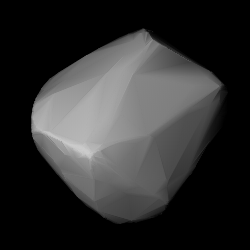Astronomy:189 Phthia
From HandWiki
 3D convex shape model of 189 Phthia | |
| Discovery[1] | |
|---|---|
| Discovered by | C. H. F. Peters |
| Discovery site | Clinton, New York |
| Discovery date | 9 September 1878 |
| Designations | |
| (189) Phthia | |
| Pronunciation | /ˈθaɪ.ə/[2] |
| A878 RA | |
| Minor planet category | main-belt |
| Orbital characteristics[3][4] | |
| Epoch 31 July 2016 (JD 2457600.5) | |
| Uncertainty parameter 0 | |
| Observation arc | 136.18 yr (49739 d) |
| |{{{apsis}}}|helion}} | 2.5415 astronomical unit|AU (380.20 Gm) |
| |{{{apsis}}}|helion}} | 2.3597 AU (353.01 Gm) |
| 2.4506 AU (366.60 Gm) | |
| Eccentricity | 0.037105 |
| Orbital period | 3.84 yr (1401.2 d) |
| Mean anomaly | 336.98° |
| Mean motion | 0° 15m 24.912s / day |
| Inclination | 5.1774° |
| Longitude of ascending node | 203.42° |
| 168.03° | |
| Physical characteristics | |
| Dimensions | 37.66±2.0 km[3] 40.91 ± 1.36 km[5] |
| Mass | (3.84 ± 0.81) × 1016 kg[5] |
| Mean density | 1.07 ± 0.25 g/cm3[5] |
| Rotation period | 22.346 h (0.9311 d)[3][6] |
| Geometric albedo | 0.2310±0.027[3] 0.1566 ± 0.0349[7] |
| S[7] (Tholen) | |
| Absolute magnitude (H) | 9.33,[3] 9.60[7] |
Phthia (minor planet designation: 189 Phthia) is a bright-coloured, rocky main belt asteroid that was discovered by German-American astronomer Christian Heinrich Friedrich Peters on September 9, 1878[1] in Clinton, New York and named after Phthia, a region of Ancient Greece .
Photometric observations of this asteroid at the Organ Mesa Observatory in Las Cruces, New Mexico during 2008 gave a light curve with a period of 22.346 ± 0.001 hours and a brightness variation of 0.26 ± 0.02 in magnitude.[6]
References
- ↑ 1.0 1.1 "Numbered Minor Planets 1–5000", Discovery Circumstances (IAU Minor Planet center), https://www.minorplanetcenter.net/iau/lists/NumberedMPs000001.html, retrieved 2013-04-07.
- ↑ Noah Webster (1884) A Practical Dictionary of the English Language
- ↑ 3.0 3.1 3.2 3.3 3.4 Yeomans, Donald K., "189 Phthia", JPL Small-Body Database Browser (NASA Jet Propulsion Laboratory), https://ssd.jpl.nasa.gov/sbdb.cgi?sstr=189, retrieved 12 May 2016.
- ↑ "The Asteroid Orbital Elements Database". Lowell Observatory. http://ftp.lowell.edu/pub/elgb/astorb.html.
- ↑ 5.0 5.1 5.2 Carry, B. (December 2012), "Density of asteroids", Planetary and Space Science 73: pp. 98–118, doi:10.1016/j.pss.2012.03.009, Bibcode: 2012P&SS...73...98C. See Table 1.
- ↑ 6.0 6.1 Pilcher, Frederick (January 2009), "Period Determinations for 33 Polyhymnia, 38 Leda, 50 Virginia, 189 Phthia, and 290 Bruna", The Minor Planet Bulletin 36 (1): pp. 25–27, Bibcode: 2009MPBu...36...25P.
- ↑ 7.0 7.1 7.2 Pravec, P. et al. (May 2012), "Absolute Magnitudes of Asteroids and a Revision of Asteroid Albedo Estimates from WISE Thermal Observations", Asteroids, Comets, Meteors 2012, Proceedings of the conference held May 16–20, 2012 in Niigata, Japan (1667), Bibcode: 2012LPICo1667.6089P. See Table 4.
External links
- 189 Phthia at AstDyS-2, Asteroids—Dynamic Site
- 189 Phthia at the JPL Small-Body Database
 |

